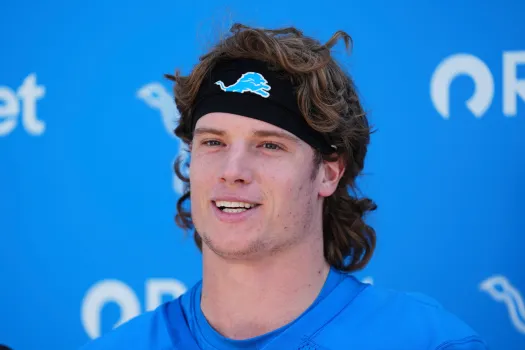In a rare crossover of professional athletes venturing into media critique, Detroit Lions wide receiver Isaac TeSlaa found himself trending on Monday morning—not for a touchdown grab or spectacular route running, but for his pointed commentary on the recent 2025 NFL Draft selections.
The statement, made during a guest appearance on the Gridiron Edge podcast, reverberated across social media platforms: “This can’t be inspiring. Some of these picks… man, it feels like GMs just threw darts at a board.” Bold words from a player known as much for his unlikely path to the NFL as for his cerebral approach to the game. But behind the viral quote lies a deeper conversation about scouting, opportunity, and what it means to “belong” in the National Football League.
From Division II Star to NFL Receiver
Before diving into his critique of the 2025 draft class, it’s important to understand TeSlaa’s background. Isaac TeSlaa wasn’t a household name coming out of high school. In fact, he wasn’t even on the radar for many Division I programs. The Minnesota native played at Hillsdale College, a Division II program where he put up jaw-dropping numbers and carved out a reputation as a sure-handed, high-IQ receiver.
He transferred to Arkansas in 2023 to face SEC-level competition and proved he belonged. Though not drafted in the first three rounds of the 2024 NFL Draft, the Detroit Lions saw something others missed. They took a late-round flyer on him—a calculated gamble that’s slowly been paying off. As a rookie, TeSlaa caught 28 passes for 314 yards and 3 touchdowns, carving out a role in one of the NFC’s most dynamic offenses.
His journey gives him a unique lens: a man who had to earn everything, evaluate himself constantly, and beat long odds to stand on the same field as 5-star talents and blue-chip prospects. It’s no wonder his analysis isn’t filtered through PR-speak—he’s seen both sides of the dream.
A Draft Analyst with Cleats
So when TeSlaa raised eyebrows with his blunt comments about the 2025 NFL Draft, it wasn’t out of jealousy or ego. Rather, it came from a place of sincerity—an athlete who had to climb to the top, watching others seemingly get airlifted there.
“There’s no hate,” he clarified later in the podcast. “But when I see wideouts who ran sloppy routes in college get drafted over polished guys with consistent tape—yeah, I question it. If I can see it on film, and scouts can see it, then why are they still getting picked early? This can’t be inspiring for the grinders out there.”
TeSlaa wasn’t just ranting; he came prepared with notes. He cited specific prospects, comparing their college production to others left undrafted or taken far later. He pointed to a Day 2 receiver who had a 17% drop rate, noting, “If I dropped 1 in every 6 passes at Hillsdale, I’d have been benched. If I did that at Arkansas, I’d be back in D2.”
He was especially critical of what he termed “traits-based overreaches”—players drafted for their 40-yard dash times or vertical jumps rather than what they actually did on the field.
The Systemic Issues Behind TeSlaa’s Critique
Many fans brushed off TeSlaa’s remarks as sour grapes or preseason noise. But insiders know his commentary hit on a growing concern: the NFL’s obsession with potential over production.
Front offices have increasingly prioritized combine numbers and athletic testing over tape and consistency. It’s not new—players like Darius Heyward-Bey and Darrius Moore were once drafted based on measurables—but it seems to be accelerating in the age of analytics.
Former NFL scout and current ESPN analyst Daniel Jeremiah offered support for TeSlaa’s viewpoint.
“TeSlaa said what a lot of us think,” Jeremiah said. “There’s a disconnect between on-field performance and draft position. Every year, a dozen guys get taken purely off potential and flame out by Year 3. Meanwhile, someone like Isaac, who’s done nothing but produce, barely got a look.”
That disconnect isn’t just frustrating—it’s demoralizing for countless college athletes grinding outside of Power Five programs. And that’s where TeSlaa’s “this can’t be inspiring” quote resonates. He’s speaking for every overlooked talent told they’re too slow, too raw, too “unorthodox.”
Lions’ Locker Room Reacts
Detroit head coach Dan Campbell was asked about TeSlaa’s comments during minicamp availability. True to form, Campbell didn’t shy away.
“Isaac’s a straight shooter,” Campbell said. “You don’t have to agree with him, but he’s earned the right to say his piece. The guy comes in every day, works his tail off, and wants to see the game get better. I respect that.”
Veteran receiver Amon-Ra St. Brown laughed when asked for his thoughts.
“Isaac’s got that podcast fire now,” he joked. “But he’s not wrong. We all see guys getting drafted and go, ‘Really?’ We just don’t say it on a mic.”
Privately, several undrafted free agents in Lions camp said TeSlaa’s comments gave them a boost.
“He’s one of us,” said rookie wideout Malik Jones from Eastern Washington. “He made it through the fire. So when he speaks up, we listen.”
NFL Draft Culture at a Crossroads
The NFL has long wrestled with how to evaluate talent fairly. The combine, pro days, analytics models, and private workouts all exist for a reason—but none are perfect. TeSlaa’s critique highlighted the tension between eye-popping potential and gritty production.
The league’s decision-makers have been shifting toward data-heavy models that prize “ceiling” over “floor.” But as more mid-rounders and undrafted players succeed—Puka Nacua in 2023, TeSlaa in 2024—the cracks in that model are growing harder to ignore.
“The draft is about projection, yes,” said NFL Network’s Bucky Brooks. “But if you’re ignoring the grind, you’re ignoring the soul of football.”
From Critic to Mentor?
Whether TeSlaa continues his journey as an informal draft analyst or simply let off steam remains to be seen. But his voice has clearly struck a chord—especially with athletes outside the spotlight. In the wake of his comments, a number of D2 and FCS players took to social media thanking him for “keeping it real.”
For his part, TeSlaa seems open to the idea of guiding younger players through the evaluation process.
“I just want guys to know it’s not over if you don’t get that call on Day 1 or Day 2,” he said. “Make ‘em see you. Make it undeniable.”
Ironically, TeSlaa is doing just that—not just through his play, but through his voice.
What’s Next for Isaac TeSlaa?
Heading into Year 2 with the Lions, TeSlaa is expected to take on a bigger role in Detroit’s offense. With Josh Reynolds departing and Jameson Williams still finding his rhythm, the door is open for TeSlaa to see increased snaps and targets.
“He’s earned it,” said offensive coordinator Ben Johnson. “He’s got strong hands, sharp routes, and a high football IQ. He makes our offense smarter.”
Still, the media attention following his draft remarks could prove distracting. But TeSlaa isn’t backing down.
“I said what I said,” he told reporters after Monday’s practice. “I didn’t come here to be a media darling. I came here to ball. If my words help one kid keep chasing it, then I’m good.”
Final Thoughts: Not Just a Soundbite
It would be easy to reduce TeSlaa’s statement—“This can’t be inspiring”—to a moment of brashness. But to do so would be to miss the point. It was a window into the NFL’s complex relationship with talent, opportunity, and the human side of a billion-dollar industry.
In a league where storylines often follow the top five picks or the next QB phenom, it’s players like Isaac TeSlaa who remind us what the game is truly about: grit, growth, and refusing to be overlooked.



